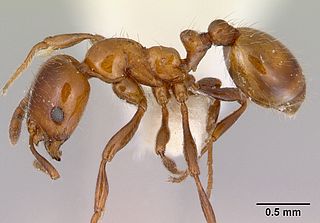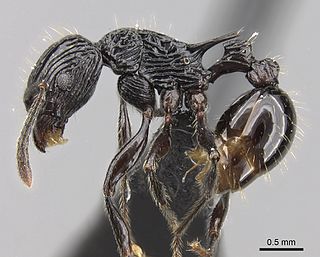
Adetomyrma is a genus of ants endemic to Madagascar. Workers of this genus are blind. The type species Adetomyrma venatrix was described in 1994, with the genus being an atypical member of its tribe, the Amblyoponini. This tribe includes the Dracula ants, members of which can feed on the hemolymph of larvae and pupae.

Myrmicinae is a subfamily of ants, with about 140 extant genera; their distribution is cosmopolitan. The pupae lack cocoons. Some species retain a functional sting. The petioles of Myrmicinae consist of two nodes. The nests are permanent and in soil, rotting wood, under stones, or in trees.

Monomorium antarcticum is an ant of the family Formicidae, endemic to New Zealand. Also known as the southern ant, this is likely New Zealand's most common native ant species. Because it is highly variable in size (3–5mm), colour, and colony structure, it is possible that it consists of a complex of closely related species. It has a generalist diet, including small arthropods, nectar, and seeds, and it also tends aphids, scale insects, and mealybugs to obtain honeydew.

Monomorium is a genus of ants in the subfamily Myrmicinae. As of 2013 it contains about 396 species. It is distributed around the world, with many species native to the Old World tropics. It is considered to be "one of the more important groups of ants," considering its widespread distribution, its diversity, and its variety of morphological and biological characteristics. It also includes several familiar pest species, such as the pharaoh ant and the flower ant.

Crematogastrini is a tribe of myrmicine ants with 64 genera and 8 fossil genera.

Eutetramorium is a small genus of ants within the subfamily Myrmicinae. To date it contains three species found in Madagascar and Comoros.

Paraparatrechina is a genus of small ants in the subfamily Formicinae. The genus contains 31 species distributed in the tropics of Africa, Asia and Australia.

Meranoplus is an Old World genus of ants in the subfamily Myrmicinae. With over 80 valid species, it is predicted that over half of the Meranoplus diversity remains undescribed, most of these from Australia.

Tyrannomyrmex is a rare tropical genus of ants in the subfamily Myrmicinae. Three similar species, only known from workers, are recognized and share small eyes and edentate mandibles.

Promyopias is an Afrotropical genus of ant in the subfamily Ponerinae containing the single species Promyopias silvestrii. The rare genus has previously been regarded as a separate genus, as a subgenus and as a provisional synonymy, but was reinstated at genus-rank in 2008.

Adetomyrma cassis is a species of ant endemic to Madagascar.

Myrmisaraka is a Malagasy genus of ants in the subfamily Myrmicinae. Described in 2014, the genus contains two species.
Malagidris is a Malagasy genus of ants in the subfamily Myrmicinae. Described in 2014, the genus contains six species.

Vitsika is a Malagasy genus of ants in the subfamily Myrmicinae. Described in 2014, the genus contains 14 species.
Leptomyrmex niger is a species of ant in the genus Leptomyrmex. Described by Carlo Emery in 1900, the species is endemic to New Guinea.
Leptomyrmex rufipes is a species of ant in the genus Leptomyrmex. Described by Carlo Emery in 1895, the species is endemic to Australia.

Leptomyrmex unicolor is a species of ant in the genus Leptomyrmex. Described by Carlo Emery in 1895, the species is endemic to Australia.

Tetramorium smaug is a species of myrmicine ant native to Ambatovy, Amber Mountain National Park, and Ivohibe in Madagascar. It was found in montane rainforests around elevations of 900–1,300 metres (3,000–4,300 ft). It is believed to live in vegetation as opposed to on the forest floor. Coloration is dark brown or black. The head and mesosoma have rough surfaces while the gaster is smooth. The head has a large number of hairs, but the amount of hair decreases on each segment posteriorly. The species has long propodeal spines with a broad base. It was named after the dragon Smaug from J. R. R. Tolkien's novel The Hobbit.















